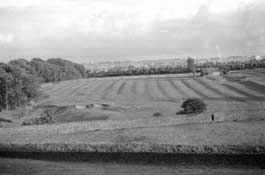|
Rigs (ridges) were a form of field drainage in which water ran
on the surface of the land, off the rigs and the down the furs (furrows)
between them.
In medieval times, rigs were typically broad and high. They were
also curved, because the teams of as many as 12 animals, usually
oxen, had to start turning before they reached the end of the rig.
Smaller iron ploughs replaced them in the late 18th century. Farm
land was enclosed, forming fields surrounded by dykes (walls) or
hedges. The rigs in these fields were straighter and lower, like
the ones in the picture, with effective drainage crop yields.
|





